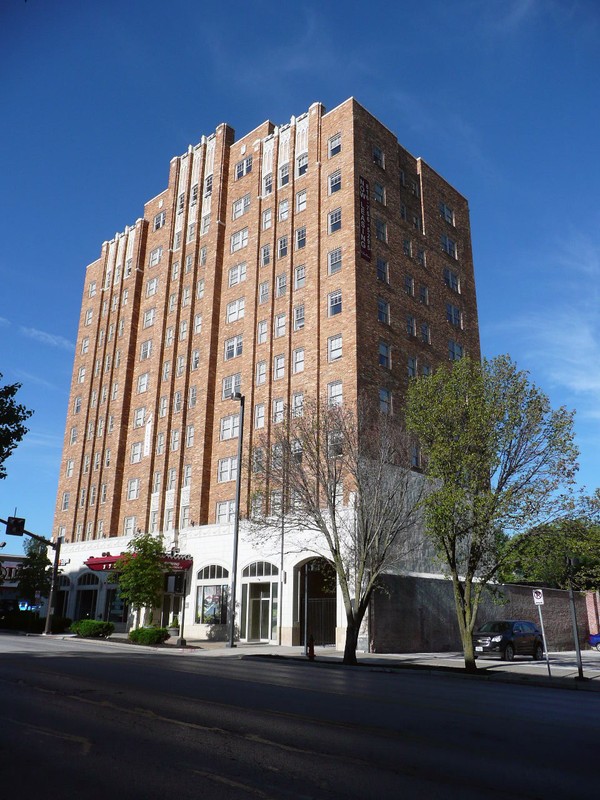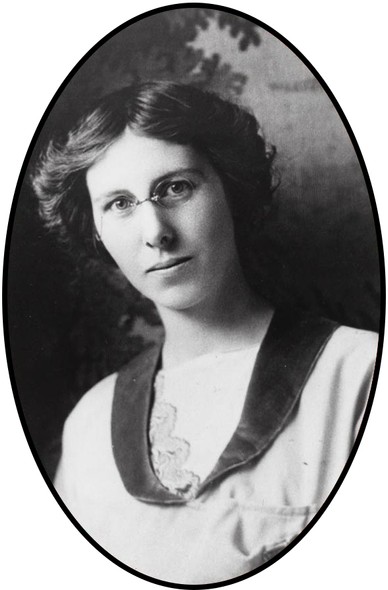Valentine on Broadway Hotel
Introduction
Text-to-speech Audio
When this historic Kansas City building was completed in 1927, it operated as the Valentine on Broadway, one of many hotel-apartment buildings that catered to middle-class professionals during the 1920s. The building was designed by Nelle E. Peters, a successful female architect in an era when men dominated the field. Nelle Peters left an indelible mark in Kansas City, designing an estimated 1,000 homes and buildings, the majority of which were constructed in the city including several other hotel-apartment buildings.
Images
The modern Valentine Apartments now occupies the historic Valentine on Broadway Hotel
%20(1).jpg)
The historic Valentine on Broadway Hotel is now the Valentine Apartments

Nelle E. Peters, a notable female architect who enjoyed great success during the 1910s and 1920s.

Backstory and Context
Text-to-speech Audio
Nelle E. Peters (1884 - 1974) was one of Kansas City's most successful early-twentieth-century architects. She designed the Art Deco eleven-story Valentine on Broadway Hotel, which opened in 1927. Peters contributed to the architectural richness of Kansas City during her short but prolific career in architecture, which spanned two decades and included hundreds of residential homes as well as apartments and several commercial buildings. The Valentine was one of the many hotel-apartment buildings constructed in the city during the 1920s, a reflection of the increase in young middle-class professionals.
Peters' success as a professional architect came at a time when men dominated the field. Born in a sod house in North Dakota, her family moved first to Minnesota and then Iowa, where she attended college from 1899 to 1903. She enjoyed excelled in mathematics, art, and sketching mechanical schematics. She developed a desire to study architecture, but Buena Vista College did not offer an architectural program. So, she moved to Sioux City in 1903, where Frank Colby of Eisentraut, Colby, and Pottenger, hired Nelle on a bet as a "drafts lady." While working for the company, she also took a correspondence course in architecture.
Eisentraut, Colby, and Pottenger had opened an office in Kansas City in 1907. Though Frank Colby hired Peters on a bet, she proved herself more than capable of handling the job, so the firm sent her to Kansas City in 1909, where she became the principal architect for numerous projects. Her arrival coincided with a population and building boom; between 1900 and 1910, Kansas City's population expanded by 80,000, with the overall population reaching 250,000. It did not take long for Peters to step away from Eisentraut, Colby, and Pottenger and open her own office, which she did in late 1909. Two years later (1911), she married fellow designer William H. Peters, who designed the Kansas City Terminal Railroad.
During their twelve years of marriage, Nelle retained her practice as an independent architect. However, in 1913, Nelle began working for Charles E. Phillips, one of Kansas City's most formidable real estate developers. By 1915, Phillips served as Nelle's principal employer. She designed dozens of apartments for Phillips, including the "literary group" of apartments located just south of Country Club Plaza that were named after writers. These buildings included the Robert Louis Stevenson Condos, Eugene Field Condos, Mark Twain Apartments, Washington Irving Apartments, Thomas Carlyle Apartments, James Russell Lowell Apartments, and the Robert Browning Apartments.
After a slow period during World War I, Peters' business grew during the 1920s when a new building boom emerged. Peters divorced her husband in 1923 and (after a pause during the war) revived her partnership with Phillips, who began developing apartment housing similar to numerous developers in other large cities; Peters completed twenty-nine projects in 1924 alone.
Nelle Peters pioneered the "kitchenette" apartment, which met the needs and demands of a growing city, especially the upwardly climbing middle class. These units offered middle-class professionals an opportunity to live in the city near trains, streetcars, jobs, theaters, shopping, and more, without the commitment of owning a home. For many, hotel apartments proved even more attractive as no lease needed to be signed, which allowed professionals to move easily if a new job opportunity arose. These apartment hotels also served a need for many professional women. In the area along Broadway where the Valentine stands, nearly six of every seven guests at hotels were permanent residents; and female residents often represented a significant percentage of residents. In some buildings that catered to women, apartment hotels were exclusively open to women.
Phillips commissioned Peters to design the Valentine on Broadway Hotel in 1927, which catered to the aforementioned middle-class residents as well as transient guests. Peters' design focused on comfort, convenience, style, and affordability. The main lobby included phone booths and mailboxes, along with a modern restaurant. Three storefronts occupied the lowest floor with retailers that catered to the hotel-apartment clientele, such as a beauty shop, barbershop, tailor, delicatessen, tavern, and others such stores over the years. Meanwhile, Peters included room designs that fit many different clients, from single guests to families and the lower-middle-class to the affluent; suites targeted to the wealthy existed on the ninth and tenth floors.
The Great Depression took a toll on Peter's career. By 1933, six years after the Valentine on Broadway opened, she had to work as a seamstress to make ends meet, which, along with the constant prejudice against women architects, contributed to her suffering a breakdown; she needed a wheelchair for a time. And, although the Great Depression proved profoundly challenging to Peter's career, she continued to work as an architect sporadically after the 1930s; Peters completed her last major work in 1959 for the Ohio Street Methodist Church in Butler, Missouri.
Meanwhile, By the 1950s, the Valentine Hotel belonged to the Kansas City Fels family and became known as Valentine-on-Broadway of Fels Hotel during the '50s and '60s. In 1958, the family spent $15k renovating the hotel lobby. But, in 1965, an incident at Gino's Italian Restaurant located in the hotel almost proved fatal for hundreds of Valentine guests. On New Year's Eve of 1965 (ushering in 1966), someone placed a timed device linked to a container filled with flammable liquid, but the device mainly failed; a fire erupted in the kitchen, but no explosion occurred (which could have killed hundreds of people). An investigation into the incident failed to resolve the matter (and the restaurant owners refused to take a lie detector test); however, the hotel owners repaired the building.
One year later, in 1967, Peters retired fully. She spent her final years in a nursing home and then died in Sedalia, Missouri, in 1974. Peters' Valentine on Broadway Hotel stands as a monument to her impact on Kansas City's expansive apartment-hotel culture and her overall work as a female architect in an era when men dominated the field. In addition to the apartments and hotel projects she undertook in K.C., she also headed projects outside Kansas and Missouri, such as the Ambassador Hotel in Tulsa, Oklahoma. She also designed commercial properties and several single-family homes, including in 1925 the private residence of the man for whom she worked closely: Charles Phillips.
Sources
Davidson, Lisa Pfueller. "A Service Machine": Hotel Guests and the Development of an Early-Twentieth-Century Building Type." Perspectives in Vernacular Architecture 10 (2005): 113-29.
Engel, Elizabeth. "Nelle E. Peters." Historic Missourians. Accessed July 31, 2021. https://historicmissourians.shsmo.org/nelle-peters.
Kansas Historical Society. "Nelle Peters." Kansapedia. March 2013. https://www.kshs.org/kansapedia/nelle-peters/18262.
Millstein, Cydney E. and Mary Ann Warfield. "Nomination Form: Valentine on Broadway Hotel." National Register of Historic Places. mo.gov. 2008. https://dnr.mo.gov/shpo/nps-nr/08000745.pdf.
Piland, Sherry. Nelle Elizabeth Peters. Pioneering Women of American Architecture. Accessed July 31, 2021. https://pioneeringwomen.bwaf.org/nelle-elizabeth-peters/.
https://www.valentineapts.com/photos.aspx
By Mwkruse - Own work, CC BY-SA 3.0, https://commons.wikimedia.org/w/index.php?curid=42296340
Nelle E. Peters. [Kansas City, Missouri, Photograph Collection, P1116]. Digitally located at https://historicmissourians.shsmo.org/nelle-peters
